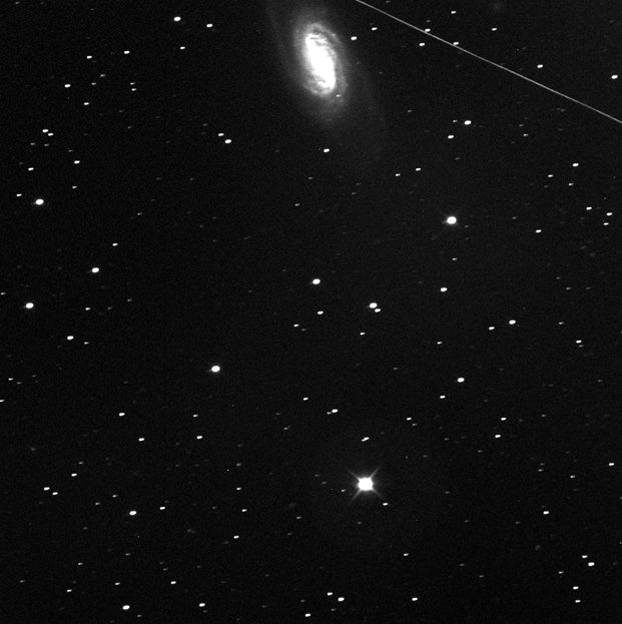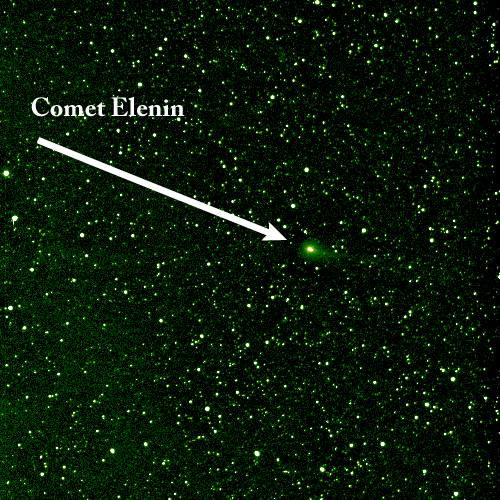'Doomsday' Comet Elenin Is Dead, NASA Says

The wimpy comet Elenin, which vaulted into the public spotlight as a so-called harbinger of doom, has met its own demise, and its remains won't be back for 12,000 years, NASA scientists say.
The comet made a swing through the inner solar system in recent months, coming closest to Earth on Oct. 16, but by that time all that was left were crumbs. The fate of comet Elenin, it seems, was sealed in September during its closest approach to the sun.
"Elenin did as new comets passing close by the sun do about two percent of the time: It broke apart," said Don Yeomans of NASA's Near-Earth Object Program Office at NASA's Jet Propulsion Laboratory in Pasadena, Calif., in a statement Monday (Oct. 25). "Elenin's remnants will also act as other broken-up comets act. They will trail along in a debris cloud that will follow a well-understood path out of the inner solar system. After that, we won't see the scraps of comet Elenin around these parts for almost 12 millennia."
Yeomans called Elenin an "ex-comet," one that should soon be forgotten.
"Comet Elenin is still dead," JPL officials wrote in a Twitter post.

On Sept. 10, comet Elenin flew within 45 million miles (75 million kilometers) of the sun and broke apart into pieces. By October, when the comet came within 22 million miles (35.4 million km) of Earth — its nearest pass with our planet — only a cloud of debris was visible in telescopes. [Gallery: Comet Elenin in Pictures]
"Comets are made up of ice, rock, dust and organic compounds and can be several miles in diameter, but they are fragile and loosely held together like dust balls," Yeomans said. "So it doesn't take much to get a comet to disintegrate, and with comets, once they break up, there is no hope of reconciliation."
Breaking space news, the latest updates on rocket launches, skywatching events and more!
The object became an Internet sensation when doomsayersproclaimed that comet Elenin would bring disaster to Earth. Some scenarios claimed comet Elenin would trigger catastrophic earthquakes due to its gravitational interactions with Earth. Another claim speculated that Elenin wasn't a comet at all, but actually a rogue planet called Nibiru that would also wreak havoc on Earth.
A NASA photo taken of where Elenin should have been on Oct. 14, just days before it reached its nearest point to Earth, revealed nothing but a stray meteor and a distant spiral galaxy.
"The meteor and the galaxy were purely coincidental, as it is what is not visible in the image that is important," NASA meteor expert Bill Cooke wrote in a blog post. "Two telescopes operated by astronomers at the Marshall Space Flight Center just stopped scanning the skies for Comet Elenin, which began fading and breaking apart back in August."

Comet Elenin was discovered in December by astronomer Leonid Elenin of Lyubertsy, Russia, who used a remotely operated observatory in the United States to make the find. The comet, also known as C/2010 X1, was about 1.2 miles (2 km) wide when it was still in one piece.
Despite the hype, all of the outlandish comet Elenin doomsday claims were completely unfounded, NASA said repeatedly. But then NASA's official responses to quell the wild speculation were taken as attempts to hide the truth about comet Elenin, the space agency said.
"I cannot begin to guess why this little comet became such a big Internet sensation," Yeomans said. "The scientific reality is this modest-sized icy dirtball's influence upon our planet is so incredibly miniscule that my subcompact automobile exerts a greater gravitational influence on Earth than the comet ever would."
Still, Yeomans expects some die-hard conspiracy theorists will maintain that comet Elenin still exists.
"Perhaps a little homage to a classic Monty Python dead parrot sketch is in order," Yeomans said. "Comet Elenin has rung down the curtain and joined the choir invisible. This is an ex-comet."
You can follow SPACE.com Managing Editor Tariq Malik on Twitter @tariqjmalik. Follow SPACE.com for the latest in space science and exploration news on Twitter @Spacedotcom and on Facebook.
Join our Space Forums to keep talking space on the latest missions, night sky and more! And if you have a news tip, correction or comment, let us know at: community@space.com.

Tariq is the award-winning Editor-in-Chief of Space.com and joined the team in 2001. He covers human spaceflight, as well as skywatching and entertainment. He became Space.com's Editor-in-Chief in 2019. Before joining Space.com, Tariq was a staff reporter for The Los Angeles Times covering education and city beats in La Habra, Fullerton and Huntington Beach. He's a recipient of the 2022 Harry Kolcum Award for excellence in space reporting and the 2025 Space Pioneer Award from the National Space Society. He is an Eagle Scout and Space Camp alum with journalism degrees from the USC and NYU. You can find Tariq at Space.com and as the co-host to the This Week In Space podcast on the TWiT network. To see his latest project, you can follow Tariq on Twitter @tariqjmalik.
